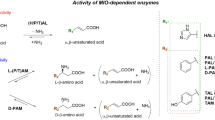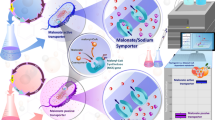Abstract
Phenylalanine ammonia-lyase (PAL) is an important enzyme that links primary metabolism to secondary metabolism. Its efficiency is often a critical factor that affects the overall flux of a related metabolic pathway, the titer of the final products, and the efficacy of PAL-based therapies. Thus, PAL is a common target for metabolic engineering, and it is of significant interest to screen efficient PALs for industrial and medical applications. In this study, a novel and efficient visible reporter assay for screening of PAL efficiency in Escherichia coli was established based on a plant type III polyketide biosynthetic pathway. The candidate PALs were co-expressed with a 4-coumarate:CoA ligase 4CL1 from Arabidopsis thaliana and curcuminoid synthase (CUS) from Oryza sativa in E. coli BL21(DE3) to form a dicinnamoylmethane biosynthetic pathway. Taking advantage of the yellow color of the product, a microplate-based assay was designed to measure the titer of dicinnamoylmethane, which was validated by HPLC analysis. The different titers of the product reflect the overall performance (expression level and enzymatic activity) of the individual PALs in E. coli. Using this system, we have screened three PALs (PAL1, PAL3, and PAL4) from Trifolium pratense, among which PAL1 showed the best performance in E. coli. The engineered E. coli strain containing PAL1, 4CL1, and CUS led to the production of dicinnamoylmethane at a high level of 0.36 g/l. Supplement of 2-fluoro-phenylalanine yielded two fluorinated dicinnamoylmethane derivatives, 6,6′-difluoro-dicinnamoylmethane and 6-fluoro-dicinnamoylmethane, of which the latter is a new curcuminoid.





Similar content being viewed by others
References
Aggarwal BB, Harikumar KB (2009) Potential therapeutic effects of curcumin, the anti-inflammatory agent, against neurodegenerative, cardiovascular, pulmonary, metabolic, autoimmune and neoplastic diseases. Int J Biochem Cell Biol 41:40–59
Aggarwal BB, Kumar A, Bharti AC (2003) Anticancer potential of curcumin: preclinical and clinical studies. Anticancer Res 23:363–398
Aggarwal BB, Sundaram C, Malani N, Ichikawa H (2007) Curcumin: the Indian solid gold. Adv Exp Med Biol 595:1–75
Calabrese JC, Jordan DB, Boodhoo A, Sariaslani S, Vannelli T (2004) Crystal structure of phenylalanine ammonia lyase: multiple helix dipoles implicated in catalysis. Biochemistry 43:11403–11416
D'Cunha GB, Satyanarayan V, Nair PM (1994) Novel direct synthesis of L-phenylalanine methyl ester by using Rhodotorula glutinis phenylalanine ammonia lyase in an organic-aqueous biphasic system. Enzyme Microb Technol 16:318–322
Debjit B, Chiranjib KKPS, Margret C, Jayakar B (2009) Turmeric: a herbal and traditional medicine. Arch Appl Sci Res 1:86–108
Dixon RA, Paiva NL (1995) Stress-induced phenylpropanoid metabolism. Plant Cell 7:1085–1097
Erez A (1973) Possible errors in quantitative determination of phenylalanine ammonia-lyase activity by spectrophotometric methods. Plant Physiol Biochem 51:409–411
Evans CT, Conrad D, Hanna K, Peterson W, Choma C, Misawa M (1987) Novel stabilization of phenylalanine ammonia-lyase catalyst during bioconversion of trans-cinnamic acid to L-phenylalanine. Appl Microbiol Biotechnol 25:399–405
Gamez A, Wang L, Sarkissian CN, Wendt D, Fitzpatrick P, Lemontt JF, Scriver CR, Stevens RC (2007) Structure-based epitope and PEGylation sites mapping of phenylalanine ammonia-lyase for enzyme substitution treatment of phenylketonuria. Mol Genet Metab 91:325–334
Goel A, Kunnumakkara AB, Aggarwal BB (2008) Curcumin as "curecumin": from kitchen to clinic. Biochem Pharmacol 75:787–809
Hahlbrock KSD (1989) Physiology and molecular biology of phenylpropanoid metabolism. Annu Rev Plant Physiol Plant Mol Biol 40:347–369
Hamaguchi T, Ono K, Yamada M (2010) Review: curcumin and Alzheimer's disease. CNS Neurosci Ther 16:285–297
Hatcher H, Planalp R, Cho J, Tortia FM, Torti SV (2008) Curcumin: from ancient medicine to current clinical trials. Cell Mol Life Sci 65:1631–1652
Ikeda K, Schiltz E, Fujii T, Takahashi M, Mitsui K, Kodera Y, Matsushima A, Inada Y, Schulz GE, Nishimura H (2005) Phenylalanine ammonia-lyase modified with polyethylene glycol: potential therapeutic agent for phenylketonuria. Amino Acids 29:283–287
Katsuyama Y, Hirose Y, Funa N, Ohnishi Y, Horinouchi S (2010) Precursor-directed biosynthesis of curcumin analogs in Escherichia coli. Biosci Biotechnol Biochem 74:641–645
Katsuyama Y, Kita T, Funa N, Horinouchi S (2009) Curcuminoid biosynthesis by two type III polyketide synthases in the herb Curcuma longa. J Biol Chem 284:11160–11170
Katsuyama Y, Matsuzawa M, Funa N, Horinouchi S (2007) In vitro synthesis of curcuminoids by type III polyketide synthase from Oryza sativa. J Biol Chem 282:37702–37709
Katsuyama Y, Matsuzawa M, Funa N, Horinouchi S (2008) Production of curcuminoids by Escherichia coli carrying an artificial biosynthesis pathway. Microbiology 154:2620–2628
Khan NU, Kamath AV, Vaidyanathan CS (1987) Study of interfering substances in a simple, new spectrophotometric assay for phenylalanine ammonia-lyase. Biochem Int 14:451–455
Klerksa MM, Zijlstra C, van Bruggen AHC (2004) Comparison of real-time PCR methods for detection of Salmonella enterica and Escherichia coli O157:H7, and introduction of a general internal amplification control. J Microbiol Methods 59:337–349
Koukol J, Conn EE (1961) Metabolism of aromatic compounds in higher plants. IV. Purification and properties of the phenylalanine deaminase of Hordeum vulgare. J Biol Chem 236:2962–2968
Kurup VP, Barrios CS (2008) Immunomodulatory effects of curcumin in allergy. Mol Nutr Food Res 52:1031–1039
Lane DJ (1991) 16S/23S rRNA sequencing. In: Stackebrandt E, Goodfellow M (eds) Nucleic acids techniques in bacterial systematics. Wiley, Chichester, pp 115–147
Lee SY, Yuk DY, Song HS, Yoon DY, Jung JK, Moon DC, Lee BS, Hong JT (2008) Growth inhibitory effects of obovatol through induction of apoptotic cell death in prostate and colon cancer by blocking of NF-kappa B. Eur J Pharmacol 582:17–25
MacDonald MJ, D'Cunha GB (2007) A modern view of phenylalanine ammonia lyase. Biochem Cell Biol 85:273–282
Moon DO, Kim MO, Lee HJ, Choi YH, Park YM, Heo MS, Kim GY (2008) Curcumin attenuates ovalbumin-induced airway inflammation by regulating nitric oxide. Biochem Biophys Res Commun 375:275–279
Muller M, Auslander S, Auslander D, Kemmer C, Fussenegger M (2012) A novel reporter system for bacterial and mammalian cells based on the non-ribosomal peptide indigoidine. Metab Eng 14:325–335
Ritter H, Schulz GE (2004) Structural basis for the entrance into the phenylpropanoid metabolism catalyzed by phenylalanine ammonia-lyase. Plant Cell 16:3426–3436
Sarkissian CN, Gamez A (2005) Phenylalanine ammonia lyase, enzyme substitution therapy for phenylketonuria, where are we now? Mol Genet Metab 86:S22–S26
Sullivan ML (2009) Phenylalanine ammonia lyase genes in red clover: expression in whole plants and in response to yeast fungal elicitor. Biol Plant 53:301–306
Vogt T (2009) Phenylpropanoid biosynthesis. Mol Plant 3:2–20
Watts KT, Lee PC, Schmidt-Dannert C (2006) Biosynthesis of plant-specific stilbene polyketides in metabolically engineered Escherichia coli. BMC Biotechnol 6:22
Xiang L, Moore BS (2005) Biochemical characterization of a prokaryotic phenylalanine ammonia lyase. J Bacteriol 187:4286–4289
Yu D, Xu F, Valiente J, Wang S, Zhan J (2013) An indigoidine biosynthetic gene cluster from Streptomyces chromofuscus ATCC 49982 contains an unusual IndB homologue. J Ind Microbiol Biot 40:159–168
Yu D, Xu F, Zeng J, Zhan J (2012) Type III polyketide synthases in natural product biosynthesis. IUBMB Life 64:285–295
Zucker M (1965) Induction of phenylalanine deaminase by light and its relation to chlorogenic acid synthesis. Plant Physiol 40:779–784
Acknowledgments
We thank Dr. Mike Sullivan (USDA), Dr. Claudia Schmidt-Dannert (University of Minnesota), and Dr. Nobutaka Funa (University of Shizuoka) for providing the corresponding plasmids. This research was supported by Award W81XWH-11-1-0458 from the Congressionally Directed Medical Research Programs of the Department of Defense, USA.
Author information
Authors and Affiliations
Corresponding author
Electronic supplementary material
Below is the link to the electronic supplementary material.
ESM 1
(DOC 38 kb)
Rights and permissions
About this article
Cite this article
Wang, S., Zhang, S., Zhou, T. et al. Design and application of an in vivo reporter assay for phenylalanine ammonia-lyase. Appl Microbiol Biotechnol 97, 7877–7885 (2013). https://doi.org/10.1007/s00253-013-5122-4
Received:
Revised:
Accepted:
Published:
Issue Date:
DOI: https://doi.org/10.1007/s00253-013-5122-4




